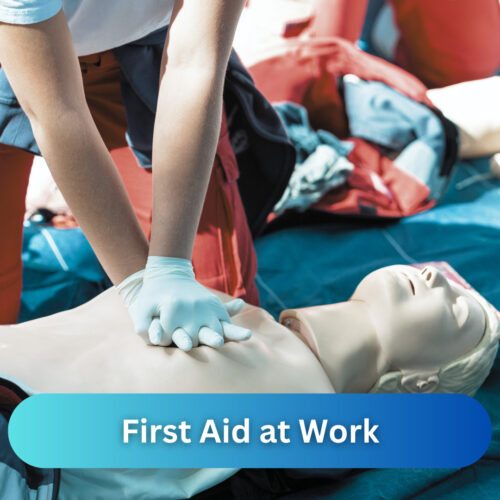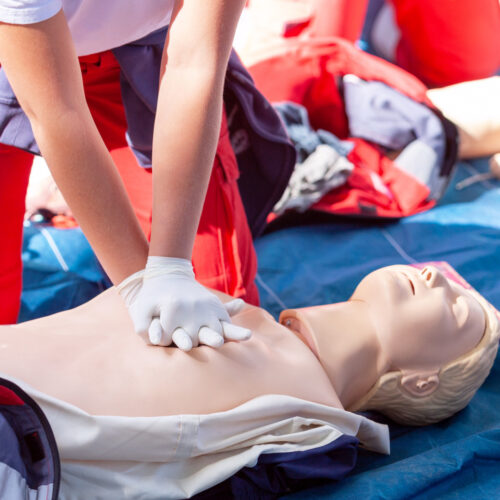- Resuscitation
- Bleeding
- Care of the unconscious casualty
- Shock
- Hypoxia
- Diabetic and epileptic emergencies
- Burns
- Fractures
- Poisoning
- Infection control
- Simple record keeping.
-
 This course covers the full syllabus, as outlined by the First Aid Approved Code of Practice 2009. The course will teach the student how to deal with:-
This course covers the full syllabus, as outlined by the First Aid Approved Code of Practice 2009. The course will teach the student how to deal with:- -
 This course covers the full syllabus, as outlined by the First Aid Approved Code of Practice 2009. The course will teach the student how to deal with:-
This course covers the full syllabus, as outlined by the First Aid Approved Code of Practice 2009. The course will teach the student how to deal with:-- Resuscitation
- Bleeding
- Care of the unconscious casualty
- Shock
- Hypoxia
- Diabetic and epileptic emergencies
- Burns
- Fractures
- Poisoning
- Infection control
- Simple record keeping.
-
 This course covers the full syllabus, as outlined by the First Aid Approved Code of Practice 2009. The course will teach the student how to deal with:-
This course covers the full syllabus, as outlined by the First Aid Approved Code of Practice 2009. The course will teach the student how to deal with:-- Resuscitation
- Bleeding
- Care of the unconscious casualty
- Shock
- Hypoxia
- Diabetic and epileptic emergencies
- Burns
- Fractures
- Poisoning
- Infection control
- Simple record keeping.
-
 This course covers the full syllabus, as outlined by the First Aid Approved Code of Practice 2009. The course will teach the student how to deal with:-
This course covers the full syllabus, as outlined by the First Aid Approved Code of Practice 2009. The course will teach the student how to deal with:-- Resuscitation
- Bleeding
- Care of the unconscious casualty
- Shock
- Hypoxia
- Diabetic and epileptic emergencies
- Burns
- Fractures
- Poisoning
- Infection control
- Simple record keeping.
-
 This First Aid at Work Requalification syllabus covers the same topics as those in the initial First Aid at Work course. Learning Outcomes In accordance with Appendix 5 & 6 of the H&S (First-Aid) Regulations 1981 Unit 1 covers the following topics:
This First Aid at Work Requalification syllabus covers the same topics as those in the initial First Aid at Work course. Learning Outcomes In accordance with Appendix 5 & 6 of the H&S (First-Aid) Regulations 1981 Unit 1 covers the following topics:- roles and responsibilities of a first aider;
- cross-infection
- recording incidents & actions;
- use of available equipment;
- assessing an incident;
- unconscious casualties (including seizure);
- cardiopulmonary resuscitation;
- safe use of an automated external defibrillator;
- choking;
- Wounded and bleeding;
- Shock;
- minor injuries (including small cuts, grazes and bruises, minor burns and scalds, small splinters
- injuries to bones, joints and muscles (including spinal injuries);
- suspected head and spinal injuries;
- chest injuries;
- burns and scalds;
- eye injuries;
- sudden poisoning;
- anaphylaxis;
- major illnesses (heart attack, stroke, epilepsy, asthma & diabetes);
- Serious bleeding including:
- embedded objects;
- sucking chest wound;
- amputations;
-
 This First Aid at Work Requalification syllabus covers the same topics as those in the initial First Aid at Work course. Learning Outcomes In accordance with Appendix 5 & 6 of the H&S (First-Aid) Regulations 1981 Unit 1 covers the following topics:
This First Aid at Work Requalification syllabus covers the same topics as those in the initial First Aid at Work course. Learning Outcomes In accordance with Appendix 5 & 6 of the H&S (First-Aid) Regulations 1981 Unit 1 covers the following topics:- roles and responsibilities of a first aider;
- cross-infection
- recording incidents & actions;
- use of available equipment;
- assessing an incident;
- unconscious casualties (including seizure);
- cardiopulmonary resuscitation;
- safe use of an automated external defibrillator;
- choking;
- Wounded and bleeding;
- Shock;
- minor injuries (including small cuts, grazes and bruises, minor burns and scalds, small splinters
- injuries to bones, joints and muscles (including spinal injuries);
- suspected head and spinal injuries;
- chest injuries;
- burns and scalds;
- eye injuries;
- sudden poisoning;
- anaphylaxis;
- major illnesses (heart attack, stroke, epilepsy, asthma & diabetes);
- Serious bleeding including:
- embedded objects;
- sucking chest wound;
- amputations;
-
 This First Aid at Work Requalification syllabus covers the same topics as those in the initial First Aid at Work course. Learning Outcomes In accordance with Appendix 5 & 6 of the H&S (First-Aid) Regulations 1981 Unit 1 covers the following topics:
This First Aid at Work Requalification syllabus covers the same topics as those in the initial First Aid at Work course. Learning Outcomes In accordance with Appendix 5 & 6 of the H&S (First-Aid) Regulations 1981 Unit 1 covers the following topics:- roles and responsibilities of a first aider;
- cross-infection
- recording incidents & actions;
- use of available equipment;
- assessing an incident;
- unconscious casualties (including seizure);
- cardiopulmonary resuscitation;
- safe use of an automated external defibrillator;
- choking;
- Wounded and bleeding;
- Shock;
- minor injuries (including small cuts, grazes and bruises, minor burns and scalds, small splinters
- injuries to bones, joints and muscles (including spinal injuries);
- suspected head and spinal injuries;
- chest injuries;
- burns and scalds;
- eye injuries;
- sudden poisoning;
- anaphylaxis;
- major illnesses (heart attack, stroke, epilepsy, asthma & diabetes);
- Serious bleeding including:
- embedded objects;
- sucking chest wound;
- amputations;
-
 This First Aid at Work Requalification syllabus covers the same topics as those in the initial First Aid at Work course. Learning Outcomes In accordance with Appendix 5 & 6 of the H&S (First-Aid) Regulations 1981 Unit 1 covers the following topics:
This First Aid at Work Requalification syllabus covers the same topics as those in the initial First Aid at Work course. Learning Outcomes In accordance with Appendix 5 & 6 of the H&S (First-Aid) Regulations 1981 Unit 1 covers the following topics:- roles and responsibilities of a first aider;
- cross-infection
- recording incidents & actions;
- use of available equipment;
- assessing an incident;
- unconscious casualties (including seizure);
- cardiopulmonary resuscitation;
- safe use of an automated external defibrillator;
- choking;
- Wounded and bleeding;
- Shock;
- minor injuries (including small cuts, grazes and bruises, minor burns and scalds, small splinters
- injuries to bones, joints and muscles (including spinal injuries);
- suspected head and spinal injuries;
- chest injuries;
- burns and scalds;
- eye injuries;
- sudden poisoning;
- anaphylaxis;
- major illnesses (heart attack, stroke, epilepsy, asthma & diabetes);
- Serious bleeding including:
- embedded objects;
- sucking chest wound;
- amputations;
-

Who is this qualification for?
The Highfield Level 3 Award in Emergency First Aid at Work RQF qualification is aimed at learners who wish to become emergency first-aiders in the workplace. This qualification meets the requirements for training emergency first-aiders in those organisations that have identified that staff need to be trained to this level within their first-aid needs assessment.
How long will it take?
To complete this qualification learners should expect to undertake 7 hours of learning, typically over one day, with a minimum contact time of 6 hours.
Topics covered
The qualification covers knowledge such as the roles and responsibilities of the first aider and how to assess an incident. The qualification also covers first aid skills in CPR and use of an AED, providing first aid to a casualty who is choking and dealing with external bleeding and hypovolaemic shock.
Assessment method
This qualification is assessed by a practical assessment and theory assessment.
